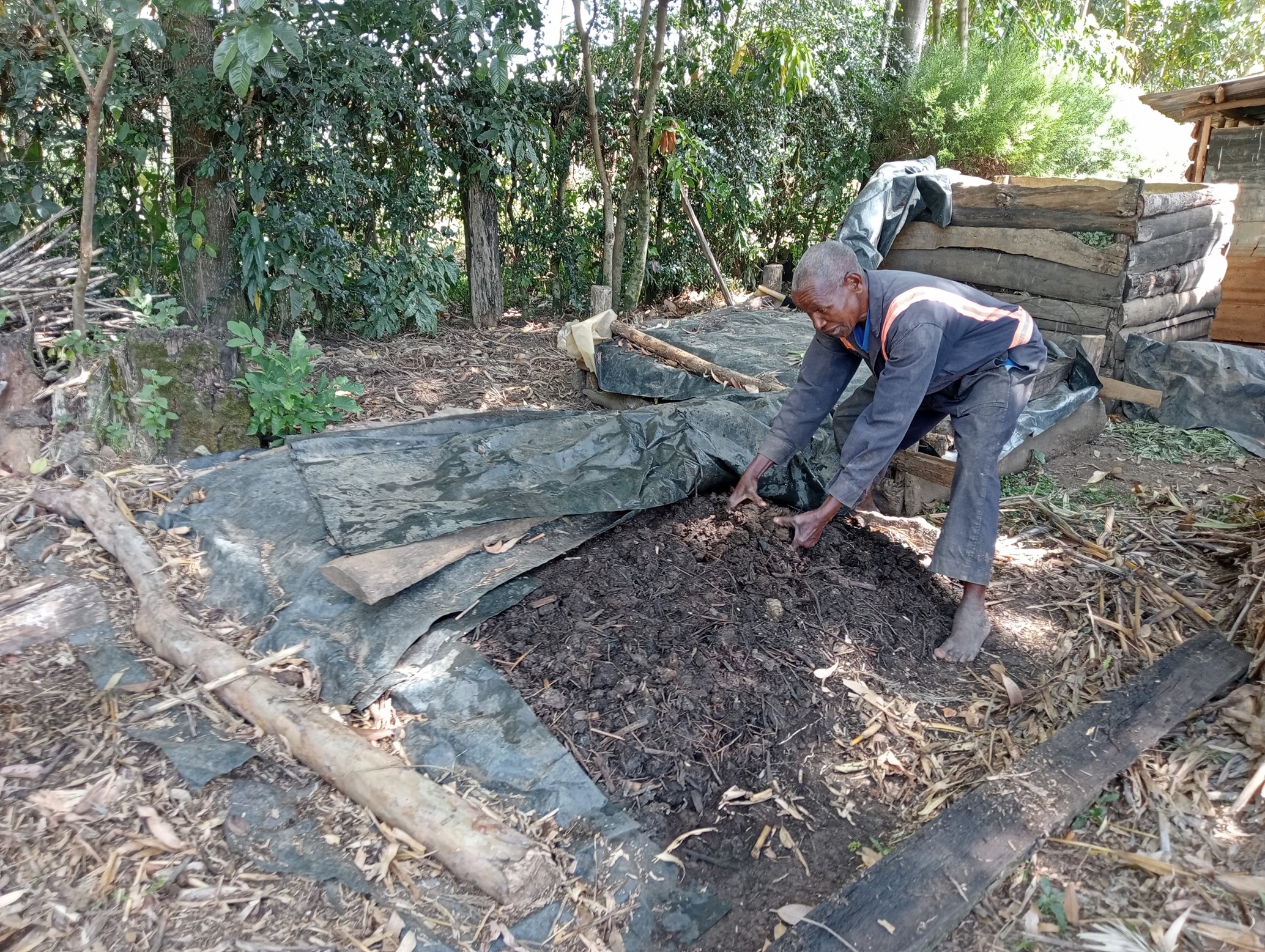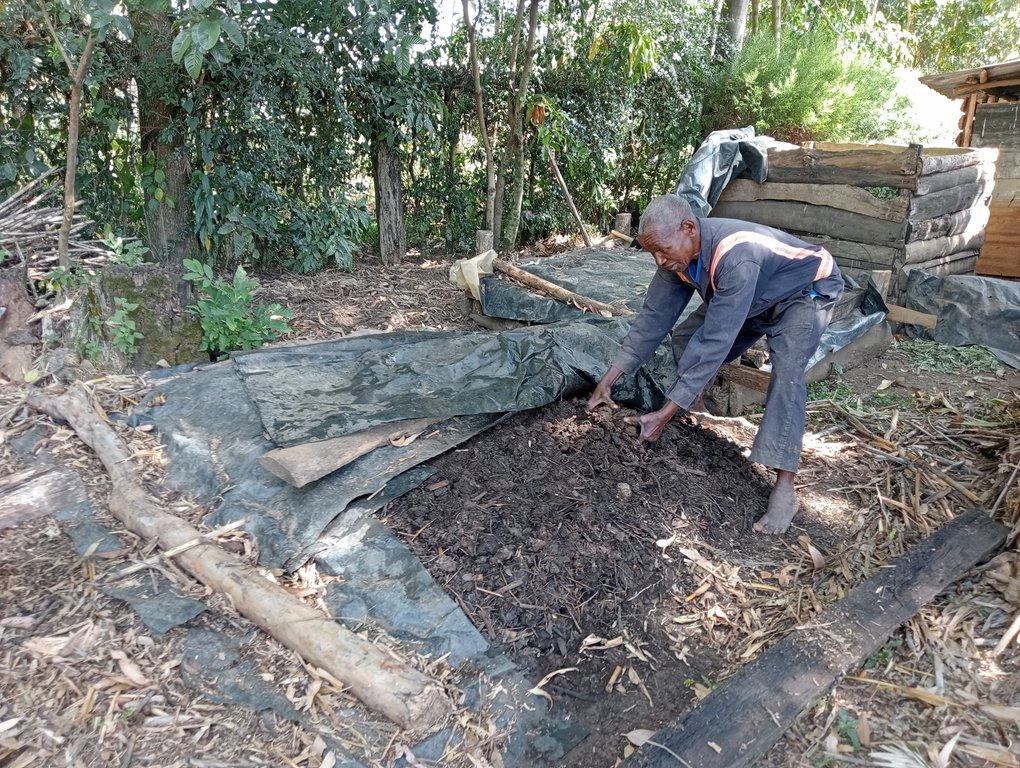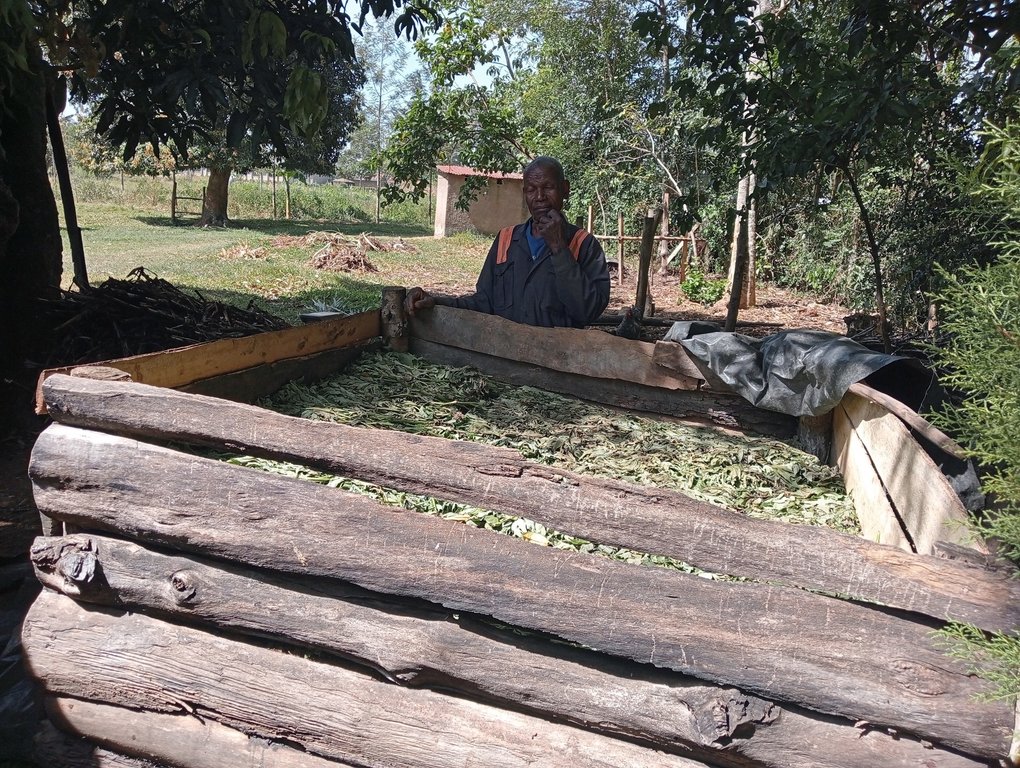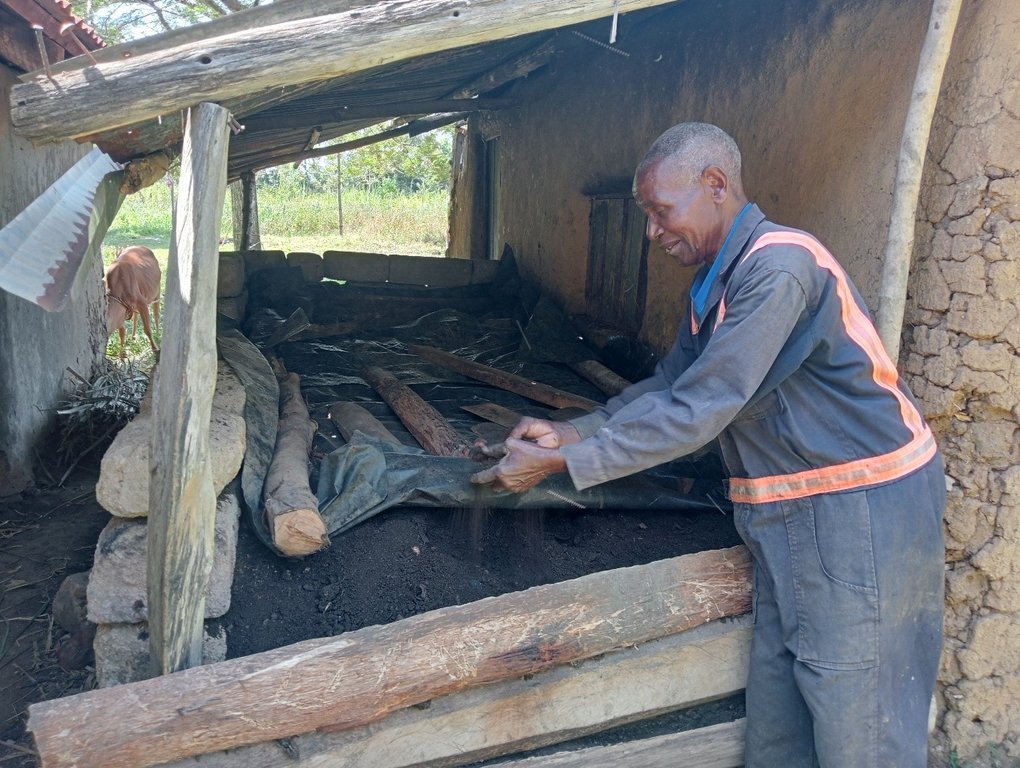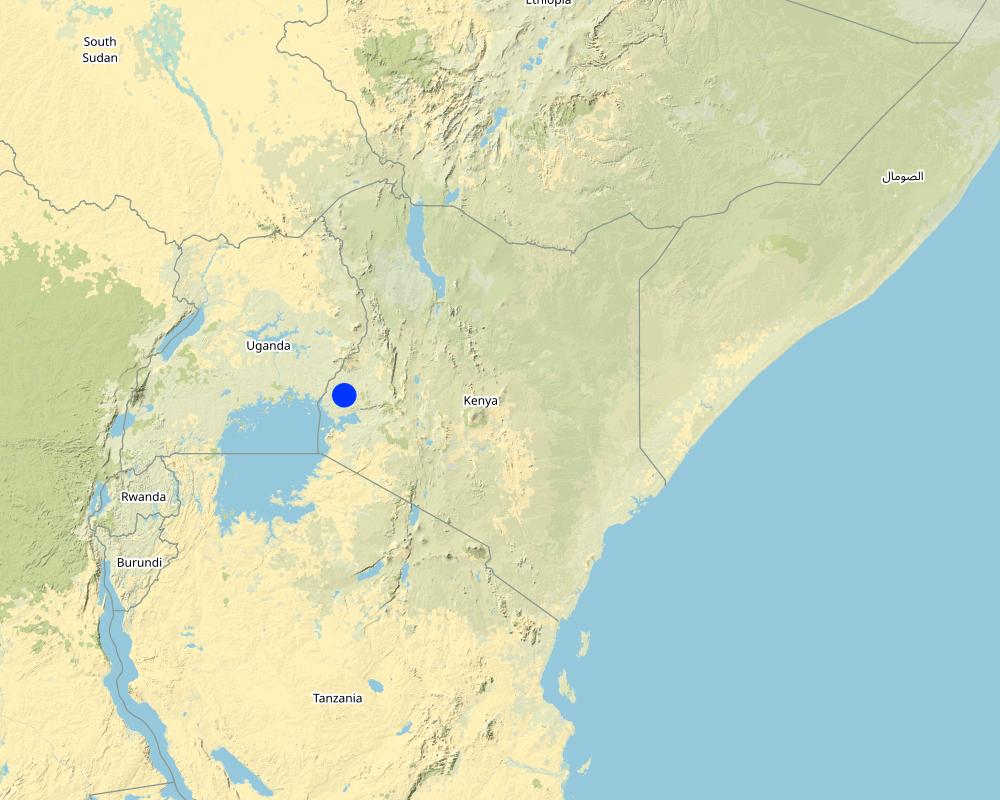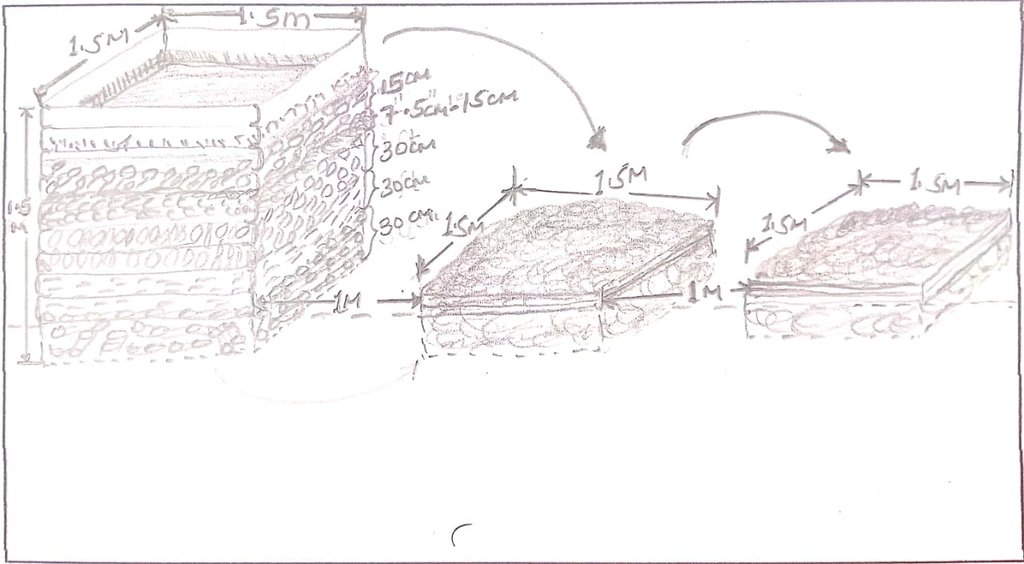Compost for organic waste management and improved crop yields [Kenya]
- Creation:
- Update:
- Compiler: William Akwanyi
- Editors: George Onyango, Innocent Faith, Noel Templer
- Reviewers: William Critchley, Rima Mekdaschi Studer
Mbolea bora (Kiswahili)
technologies_6648 - Kenya
View sections
Expand all Collapse all1. General information
1.2 Contact details of resource persons and institutions involved in the assessment and documentation of the Technology
Key resource person(s)
land user:
Anyanga Matthews George
Welthungerhilfe
Kenya
SLM specialist:
SLM specialist:
Name of project which facilitated the documentation/ evaluation of the Technology (if relevant)
Soil protection and rehabilitation for food security (ProSo(i)l)Name of the institution(s) which facilitated the documentation/ evaluation of the Technology (if relevant)
Deutsche Gesellschaft für Internationale Zusammenarbeit (GIZ)Name of the institution(s) which facilitated the documentation/ evaluation of the Technology (if relevant)
CIAT International Center for Tropical Agriculture (CIAT International Center for Tropical Agriculture) - Kenya1.3 Conditions regarding the use of data documented through WOCAT
The compiler and key resource person(s) accept the conditions regarding the use of data documented through WOCAT:
Yes
1.4 Declaration on sustainability of the described Technology
Is the Technology described here problematic with regard to land degradation, so that it cannot be declared a sustainable land management technology?
No
Comments:
Farmers who have implemented the technology have recorded good harvests from their farms. The product of manure has improved their soils.
1.5 Reference to Questionnaire(s) on SLM Approaches (documented using WOCAT)
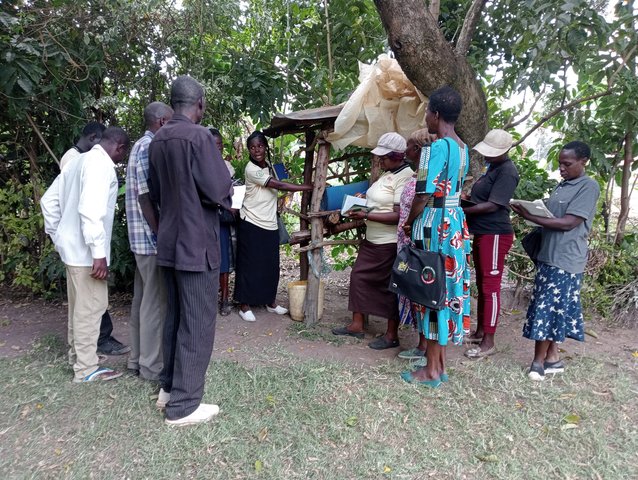
Community Resource Persons (CRP) in agricultural extension [Kenya]
Community Resource Persons (CRP) form a farmer-to-farmer learning approach that bridges the gap in agricultural extension, increases farmers' access to agricultural information (SLM knowledge), and increases the adoption of SLM practices.
- Compiler: William Akwanyi
2. Description of the SLM Technology
2.1 Short description of the Technology
Definition of the Technology:
Composting with on-farm organic solid waste management improves the soil sustainably and raises crop yields.
2.2 Detailed description of the Technology
Description:
Composting is a natural process of converting organic materials such as plant leaves, and food remains into a nutrient-rich soil-enhancing amendment called compost (if mainly from vegetative matter) or manure (if mainly from animal dung). It involves breaking organic matter down into humus/ compost by aerobic microorganisms - with by-products of water, heat, ammonia (NH3), and carbon dioxide (CO2). Humus is a dark and crumbly natural form of fertilizer applied to the soil to improve crop production. Composting is cost-effective since it can be made from locally available materials such as leaves, plant residues, food remains, cow dung, poultry droppings, animal urine, soil, etc. Composting is thus an on-farm solid waste management measure. When made correctly it can improve carbon sequestration in the soil (compost is carbon-rich) and prevent methane emissions (a greenhouse gas) since methane-producing microbes become inactive in aerobic conditions (in the presence of oxygen).
There are many ways of preparing compost. This method involves three key stages; mixing brown organic materials, such as twigs, and green materials, such as fresh leaves that are nitrogen-rich and moist. In the first stage, brown and green materials are layered, beginning with a 30 cm layer of twigs at the bottom, followed by a 30 cm layer of dry matter, such as maize straw chopped to a maximum of 7.5 cm. This is followed by a 30 cm layer of dry grass and dry leaves covered by a 7.5 cm – 15 cm layer of fresh cow dung. The fresh cow dung is covered by a 15 cm layer of fresh tithonia (an exotic plant) that is completely covered by a layer of ash and sprayed uniformly using 10 litres of animal urine and finally completely covered by a layer of soil or manure. All the above inputs except urine are sprayed with 10 – 20 litres of water. The pile is then completely covered with a black polythene sheet to help absorb heat, prevent the entry of rainwater, and prevent volatilization of nitrogen, i.e., the conversion of ammonium into ammonia gas, and left to decompose for 21 to 30 days.
The second stage involves mixing and transferring all the material except the twigs, to another space. The heap is again completely covered with a black polythene sheet to help absorb heat, prevent rainwater entry, and prevent nitrogen volatilization. It is again left to decompose for another 21 to 30 days. The third stage, like the second stage, involves completely mixing and transferring all the material from the second stage to another space and completely covering the heap with a black polythene sheet to help absorb heat and prevent the entry of rainwater. The contents are allowed to decompose for another 21 to 30 days, after which they are ready-to-use compost. The compost is stored under shade and covered with a black polythene sheet again to prevent nitrogen volatilization.
One heap of compost (first stage: 1.5 m by 1.5 m by 1.5 m) produces about 5 tonnes of ready-to-use compost. Composting takes about 90 days; hence, provided that all inputs are available, a farmer can produce compost 4 times each year from the same heaping point, i.e., about 20 tonnes. Normally, a 0.4-hectare farm requires about 20 tonnes of this compost. However, the amount varies from farm to farm depending on the conditions of the soil and the crop(s) to be grown. It is important that soil testing is done to determine the conditions of the soil to ensure that the compost is being used in the most effective manner.
Compost is carried to the farm on wheelbarrows and in buckets and is applied at the farm during planting time where a handful of compost is applied in the planting hole and mixed with soil before planting. It is again applied around the base of the crop and completely covered with soil. Preparation of compost in conservation agriculture situations could pose the problem of competition for plant material since plant material is used in conservation agriculture to cover the soil. To manage this, a farmer implementing both composting and conservation agriculture may have to acquire plant material for composting from other sources such as purchasing stover from other farmer who are not implementing conservation agriculture. In addition, the farmer could also use hedge trimmings as plant material for composting, especially if the farmer has a live fence.
2.3 Photos of the Technology
General remarks regarding photos:
Composting is a multi-stage process. The inputs/ materials in each stage must be completely covered with a black polythene sheet to help absorb heat, prevent the entry of rainwater, and prevent volatilization of nitrogen. The materials are allowed to decompose for at least 21 days in each stage before they are completely mixed and transferred to the next.
2.5 Country/ region/ locations where the Technology has been applied and which are covered by this assessment
Country:
Kenya
Region/ State/ Province:
Kakamega County in western Kenya
Further specification of location:
Elang'ata Village, Bulanda Sub-location, Imanga Location, Marama Central Ward, Butere Sub-county
Specify the spread of the Technology:
- applied at specific points/ concentrated on a small area
Is/are the technology site(s) located in a permanently protected area?
No
Comments:
The farm where the technology is implemented is not in a protected area.
Map
×2.6 Date of implementation
Indicate year of implementation:
2018
2.7 Introduction of the Technology
Specify how the Technology was introduced:
- through land users' innovation
- as part of a traditional system (> 50 years)
- through projects/ external interventions
Comments (type of project, etc.):
For years, the farmer has been converting farm wastes into manure. However, the Soil Protection and Rehabilitation of Degraded Soil for Food Security (ProSoil) project came in and taught them an improved method of composting that takes a shorter time compared with the traditional method, and prevents loss of nutrients during composting.
3. Classification of the SLM Technology
3.1 Main purpose(s) of the Technology
- improve production
- reduce, prevent, restore land degradation
- adapt to climate change/ extremes and its impacts
- mitigate climate change and its impacts
- create beneficial economic impact
3.2 Current land use type(s) where the Technology is applied
Land use mixed within the same land unit:
Yes
Specify mixed land use (crops/ grazing/ trees):
- Agro-silvopastoralism

Cropland
- Annual cropping
- Perennial (non-woody) cropping
- Tree and shrub cropping
Annual cropping - Specify crops:
- cereals - maize
- fodder crops - grasses
- legumes and pulses - beans
- root/tuber crops - cassava
- vegetables - other
Annual cropping system:
Maize/sorghum/millet intercropped with legume
Perennial (non-woody) cropping - Specify crops:
- banana/plantain/abaca
Tree and shrub cropping - Specify crops:
- avocado
- fruits, other
- mango, mangosteen, guava
- papaya
Number of growing seasons per year:
- 2
Specify:
Long and short rain seasons
Is intercropping practiced?
Yes
If yes, specify which crops are intercropped:
Maize and beans
Is crop rotation practiced?
Yes
If yes, specify:
Some sections of the farm are left fallow during the short rains to allow for soil regeneration.

Grazing land
Intensive grazing/ fodder production:
- Cut-and-carry/ zero grazing
- Improved pastures
Animal type:
- cattle - dairy
- cattle - dairy and beef (e.g. zebu)
- poultry
Is integrated crop-livestock management practiced?
Yes
If yes, specify:
Cattle dung and poultry droppings are used as inputs in composting. Compost is applied on soil where livestock fodder is planted.
Products and services:
- economic security, investment prestige
- eggs
- manure as fertilizer/ energy production
- meat
- milk
Species:
cattle - dairy
Count:
2
Species:
cattle - dairy and beef (e.g. zebu)
Count:
3
Species:
poultry
Count:
10
Comments:
There are assorted trees on the farm, and these provide litter which is an input in composting.
3.3 Has land use changed due to the implementation of the Technology?
Has land use changed due to the implementation of the Technology?
- No (Continue with question 3.4)
3.4 Water supply
Water supply for the land on which the Technology is applied:
- rainfed
Comments:
Crops are planted only during the rainy seasons since there is no irrigation.
3.5 SLM group to which the Technology belongs
- integrated crop-livestock management
- integrated soil fertility management
- waste management/ waste water management
3.6 SLM measures comprising the Technology

agronomic measures
- A2: Organic matter/ soil fertility
- A6: Residue management
A6: Specify residue management:
A 6.3: collected
Comments:
Plant residues, especially leaves and soft branches are collected and used as input in composting. However, some plant matter is retained in the farm to naturally decompose and turn into manure at the farm. The farmer does not collect plant residues from protected areas. He has planted tithonia at some sections of the hedges at his farm; this provides the main source of tithonia. However, he sometimes harvests tithonia from his neighbours' hedges upon request.
3.7 Main types of land degradation addressed by the Technology

chemical soil deterioration
- Cn: fertility decline and reduced organic matter content (not caused by erosion)
- Ca: acidification
- Cp: soil pollution
Comments:
Covering of compost-making materials and the final compost reduces loss of nitrogen through volatilization of ammonium into ammonia gas. Compost raises the pH of soils when applied at the farm. Compost contains living organisms (bacteria and fungi) that degrade soil pollutants into non-toxic substances.
3.8 Prevention, reduction, or restoration of land degradation
Specify the goal of the Technology with regard to land degradation:
- prevent land degradation
- restore/ rehabilitate severely degraded land
Comments:
Compost improves soil structure and porosity. Compost balances soil pH.
4. Technical specifications, implementation activities, inputs, and costs
4.1 Technical drawing of the Technology
Technical specifications (related to technical drawing):
Stage 1: about 30 cm deep under the ground, 1.5 m long by 1.5 m wide by 1.5 m high, including the 30 cm below the ground. Constructed using timber off-cuts (locally known as magogo) supported on posts at corners using nails. From bottom: 30 cm of twigs to extend some few inches above the ground to allow air circulation, 30 cm of dry matter e.g., maize straw chopped to 7.5 cm maximum, 30 cm dry grass and leaves, 7.5 cm - 15 cm layer of fresh cow dung, 15 cm layer of fresh tithonia, layer of ash, layer of soil or manure, black polythene sheet cover.
Stages 2 and 3: about 1-ft deep under the ground, 1.5 m long by 1.5 m wide, height depends on the volume of the material.
Allow space of no more than 1 m from one stage to the other for easy of mixing and transfer of materials from one stage to the next.
Author:
William Onura
Date:
26/01/2023
4.2 General information regarding the calculation of inputs and costs
Specify how costs and inputs were calculated:
- per Technology unit
Specify unit:
Heap of compost
Specify dimensions of unit (if relevant):
1.5 m by 1.5 m by 1.5 m
other/ national currency (specify):
KES
If relevant, indicate exchange rate from USD to local currency (e.g. 1 USD = 79.9 Brazilian Real): 1 USD =:
122.95
Indicate average wage cost of hired labour per day:
200
4.3 Establishment activities
| Activity | Timing (season) | |
|---|---|---|
| 1. | Digging of pits | At least 3 months before planting time |
| 2. | Framework construction with off cuts | At least 3 months before planting time |
| 3. | Filling stage one with inputs | At least 3 months before planting time |
Comments:
Composting takes about 3 months; hence, the farmer should have the structures for composting at least 3 months before the planting time. A farmer can produce 20 tonnes of compost from 1 heap (1.5 m by 1.5 m by 1.5 m).
4.4 Costs and inputs needed for establishment
| Specify input | Unit | Quantity | Costs per Unit | Total costs per input | % of costs borne by land users | |
|---|---|---|---|---|---|---|
| Labour | Framework construction | Man-days | 2.0 | 200.0 | 400.0 | 100.0 |
| Labour | Filling inputs | Man-days | 1.0 | 200.0 | 200.0 | 100.0 |
| Equipment | Jembe (hoe) | No. | 1.0 | 80.0 | 80.0 | |
| Equipment | Spade | No. | 1.0 | 90.0 | 90.0 | |
| Equipment | Fork hoe | No. | 1.0 | 70.0 | 70.0 | |
| Equipment | Wheelbarrow | No. | 1.0 | 800.0 | 800.0 | |
| Equipment | Hummer | No. | 1.0 | 100.0 | 100.0 | 100.0 |
| Equipment | Handsaw | No. | 1.0 | 200.0 | 200.0 | 100.0 |
| Plant material | Twigs | Wheelbarrow | 2.0 | 100.0 | 200.0 | 100.0 |
| Plant material | Dry matter | Wheelbarrow | 6.0 | 50.0 | 300.0 | 100.0 |
| Plant material | Dry grass and leaves | 90 Kg sack | 3.0 | 50.0 | 150.0 | 100.0 |
| Plant material | Fresh tithonia | 90 Kg sack | 3.0 | 50.0 | 150.0 | 100.0 |
| Fertilizers and biocides | Ash | 90 Kg sack | 0.4 | 200.0 | 80.0 | 100.0 |
| Fertilizers and biocides | Animal urine | 10 litre container | 1.0 | 125.0 | 125.0 | 100.0 |
| Fertilizers and biocides | Soil or manure | Wheelbarrow | 1.0 | 300.0 | 300.0 | 100.0 |
| Fertilizers and biocides | Fresh cow dung | Wheelbarrow | 3.0 | 200.0 | 600.0 | 100.0 |
| Construction material | Timber off-cuts | Pieces | 16.0 | 100.0 | 1600.0 | 100.0 |
| Construction material | Wooden posts | Pieces | 4.0 | 50.0 | 200.0 | 100.0 |
| Construction material | Nails (assorted sizes) | Kgs | 3.0 | 200.0 | 600.0 | 100.0 |
| Other | Water | 20 litres container | 4.0 | 5.0 | 20.0 | 100.0 |
| Total costs for establishment of the Technology | 6265.0 | |||||
| Total costs for establishment of the Technology in USD | 50.96 | |||||
If land user bore less than 100% of costs, indicate who covered the remaining costs:
ProSoil project
Comments:
The ProSoil project through Welthungerhilfe provided hoes, fork hoes, wheelbarrows, and spades to the farmers. The costs of these implements are KES 400/- for a hoe, KES 350/- for a fork hoe, KES 4,000/- for a wheelbarrow, KES 450/- for a spade, KES 500/- for a hummer, and KES 1,000/- for a handsaw. It is assumed that the farmer will be able to use the hoe, fork hoe, spade, hummer, and handsaw over a period of 5 years, and a wheelbarrow over a period of 10 years before these implements will have depreciated to a point where they will not be useable. The cost is thus spread over the years when the farmer will be able to use the implement.
4.5 Maintenance/ recurrent activities
| Activity | Timing/ frequency | |
|---|---|---|
| 1. | Turning at each stage | 21 - 30 days after start of each stage |
| 2. | Refilling at the first stage | At turning from the first stage |
| 3. | Distribution to the farm | When planting and at first weeding (i.e., 3rd week after planting) |
Comments:
Turning involves complete mixing and transfer of the inputs from one stage to the next. Compost is applied at the farm during planting time where a handful of compost is applied in the planting hole and mixed with soil before planting. It is again applied around the base of the crop and completely covered with soil.
4.6 Costs and inputs needed for maintenance/ recurrent activities (per year)
| Specify input | Unit | Quantity | Costs per Unit | Total costs per input | % of costs borne by land users | |
|---|---|---|---|---|---|---|
| Labour | Complete mixing and turning from stage one to stage two and from stage two to stage three | Man-days | 4.0 | 200.0 | 800.0 | 100.0 |
| Labour | Refilling with new materials at the first stage | Man-days | 1.0 | 200.0 | 200.0 | 100.0 |
| Labour | Transfer to storage | Man-days | 2.0 | 200.0 | 400.0 | 100.0 |
| Labour | Distribution to the farm | Man-days | 2.0 | 200.0 | 400.0 | 100.0 |
| Equipment | Hoe | No. | 1.0 | 80.0 | 80.0 | |
| Equipment | Fork hoe | No. | 1.0 | 90.0 | 90.0 | |
| Equipment | Spade | No. | 1.0 | 70.0 | 70.0 | |
| Equipment | Wheelbarrow | No. | 1.0 | 400.0 | 400.0 | |
| Plant material | Dry matter | Wheelbarrow | 6.0 | 50.0 | 300.0 | 100.0 |
| Plant material | Dry grass and leaves | 90Kg sack | 3.0 | 50.0 | 150.0 | 100.0 |
| Plant material | Fresh tithonia | 90Kg sack | 3.0 | 50.0 | 150.0 | 100.0 |
| Fertilizers and biocides | Ash | 90 Kg sack | 0.4 | 200.0 | 80.0 | 100.0 |
| Fertilizers and biocides | Animal urine | 10 litre container | 1.0 | 125.0 | 125.0 | 100.0 |
| Fertilizers and biocides | Soil or manure | Wheelbarrow | 1.0 | 300.0 | 300.0 | 100.0 |
| Fertilizers and biocides | Fresh cowdung | Wheelbarrow | 3.0 | 200.0 | 600.0 | 100.0 |
| Other | Water | 20 litres container | 4.0 | 5.0 | 20.0 | 100.0 |
| Total costs for maintenance of the Technology | 4165.0 | |||||
| Total costs for maintenance of the Technology in USD | 33.88 | |||||
If land user bore less than 100% of costs, indicate who covered the remaining costs:
ProSoil project
Comments:
The hoes, fork hoes, wheelbarrows, and spades provided by the ProSoil project through Welthungerhilfe are fixed assets and are used for years by the farmer before they can wear out. The farmer can use these implements for other work at the farm. The costs of these implements are KES 400/- for a hoe, KES 350/- for a fork hoe, KES 4,000/- for a wheelbarrow, and KES 450/- for a spade. It is assumed that the farmer will be able to use the hoe, fork hoe, and spade over a period of 5 years, and a wheelbarrow over a period of 10 years before these implements will have depreciated to a point where they will not be useable. The cost is thus spread over the years when the farmer will be able to use the implement. The twigs are reused during the refilling process since they take long to decompose.
4.7 Most important factors affecting the costs
Describe the most determinate factors affecting the costs:
Rate of man-days vary from one place to another. It is not easy to attach monetary value to some of the input e.g., animal urine, cow dung, and water.
Exchange rate for January 2023, source: European Commission/ InfoEuro online at https://commission.europa.eu/funding-tenders/procedures-guidelines-tenders/information-contractors-and-beneficiaries/exchange-rate-inforeuro_en
5. Natural and human environment
5.1 Climate
Annual rainfall
- < 250 mm
- 251-500 mm
- 501-750 mm
- 751-1,000 mm
- 1,001-1,500 mm
- 1,501-2,000 mm
- 2,001-3,000 mm
- 3,001-4,000 mm
- > 4,000 mm
Specifications/ comments on rainfall:
Monthly rainfall variability is high with some months such as January recording less than 5 mm of total rainfall.
Indicate the name of the reference meteorological station considered:
Kakamega Meteorological Station
Agro-climatic zone
- humid
The climate in the area favours most agricultural activities.
5.2 Topography
Slopes on average:
- flat (0-2%)
- gentle (3-5%)
- moderate (6-10%)
- rolling (11-15%)
- hilly (16-30%)
- steep (31-60%)
- very steep (>60%)
Landforms:
- plateau/plains
- ridges
- mountain slopes
- hill slopes
- footslopes
- valley floors
Altitudinal zone:
- 0-100 m a.s.l.
- 101-500 m a.s.l.
- 501-1,000 m a.s.l.
- 1,001-1,500 m a.s.l.
- 1,501-2,000 m a.s.l.
- 2,001-2,500 m a.s.l.
- 2,501-3,000 m a.s.l.
- 3,001-4,000 m a.s.l.
- > 4,000 m a.s.l.
Indicate if the Technology is specifically applied in:
- not relevant
Comments and further specifications on topography:
The farm is located at an area that is higher in altitude compared to other areas in the larger area. The average altitude for the area is 1,350m above sea level but the farm is at 1,401m above sea level.
5.3 Soils
Soil depth on average:
- very shallow (0-20 cm)
- shallow (21-50 cm)
- moderately deep (51-80 cm)
- deep (81-120 cm)
- very deep (> 120 cm)
Soil texture (topsoil):
- medium (loamy, silty)
Soil texture (> 20 cm below surface):
- coarse/ light (sandy)
Topsoil organic matter:
- medium (1-3%)
If available, attach full soil description or specify the available information, e.g. soil type, soil PH/ acidity, Cation Exchange Capacity, nitrogen, salinity etc.
Soil pH of most farms in the area ranges from moderately acid (5.50) to moderately alkaline (7.80).
5.4 Water availability and quality
Ground water table:
5-50 m
Availability of surface water:
good
Water quality (untreated):
poor drinking water (treatment required)
Water quality refers to:
both ground and surface water
Is water salinity a problem?
No
Is flooding of the area occurring?
No
Comments and further specifications on water quality and quantity:
There are several boreholes in the area and according to interviews with some borehole owners, the depts are not more than 50 metres.
5.5 Biodiversity
Species diversity:
- medium
Habitat diversity:
- medium
Comments and further specifications on biodiversity:
The area has high agrobiodiversity since most farms are under crops and trees.
5.6 Characteristics of land users applying the Technology
Sedentary or nomadic:
- Semi-nomadic
Market orientation of production system:
- mixed (subsistence/ commercial)
Off-farm income:
- > 50% of all income
Relative level of wealth:
- average
Individuals or groups:
- individual/ household
Level of mechanization:
- manual work
- animal traction
Gender:
- women
- men
Age of land users:
- youth
- middle-aged
- elderly
Indicate other relevant characteristics of the land users:
The farmer uses the land together with his other family members.
5.7 Average area of land used by land users applying the Technology
- < 0.5 ha
- 0.5-1 ha
- 1-2 ha
- 2-5 ha
- 5-15 ha
- 15-50 ha
- 50-100 ha
- 100-500 ha
- 500-1,000 ha
- 1,000-10,000 ha
- > 10,000 ha
Is this considered small-, medium- or large-scale (referring to local context)?
- medium-scale
Comments:
Farmers with more than 2 ha in the area are considered to have large pieces of land since there is high level of land fragmentation in the area.
5.8 Land ownership, land use rights, and water use rights
Land ownership:
- individual, not titled
- individual, titled
Land use rights:
- leased
- individual
Water use rights:
- open access (unorganized)
- individual
Are land use rights based on a traditional legal system?
No
Specify:
Each landowner has full control of the way he/ she wants to use his/ her land.
Comments:
The farmer has an official ownership title for his piece of land. He also leases other people's pieces of land for farming. Water in the streams and springs is freely accessed without restrictions. There is a borehole in the neighbourhood, and the managers of this borehole have set rules for accessing the water thereat.
5.9 Access to services and infrastructure
health:
- poor
- moderate
- good
education:
- poor
- moderate
- good
technical assistance:
- poor
- moderate
- good
employment (e.g. off-farm):
- poor
- moderate
- good
markets:
- poor
- moderate
- good
energy:
- poor
- moderate
- good
roads and transport:
- poor
- moderate
- good
drinking water and sanitation:
- poor
- moderate
- good
financial services:
- poor
- moderate
- good
Comments:
The above rating varies from one village to the other.
6. Impacts and concluding statements
6.1 On-site impacts the Technology has shown
Socio-economic impacts
Production
crop production
Quantity before SLM:
Less than 4
Quantity after SLM:
More than 8
Comments/ specify:
Quantity refers to the number of 90 Kg bags of maize produced per acre. Based on measurement by the farmer.
crop quality
Comments/ specify:
Not easy to quantify. The crops do better compared to how they could do in the past, yet he does not use inorganic fertilizers. Based on estimation by the farmer.
fodder production
Quantity before SLM:
2
Quantity after SLM:
3 - 4
Comments/ specify:
Quantity refers to harvesting cycles for nappier grass from the same farm. He applies compost on the pieces of land where he has grown fodder. The fodder does better than how it used to do before when he was not applying compost.
fodder quality
Comments/ specify:
He applies compost on the pieces of land where he has grown fodder.
animal production
Quantity before SLM:
1 - 3
Quantity after SLM:
3 - 10
Comments/ specify:
Quantity refers to the amount of milk in litres from one cow. He gets more milk from his cows as compared to what he used to get before the SLM since applying compost on the pieces of land where he has grown fodder makes the fodder to grow faster. Milk production is often at the peak during early lactation months.
risk of production failure
Quantity before SLM:
Over 50
Quantity after SLM:
Less than 10
Comments/ specify:
Quantity refers to the percentage probability of the crop failing to do well. Quote from the farmer, '... it was 50 50 getting any produce before I started using compost ...' meaning that there was high chance that the crop could fail due to poor soils. Compost is a rich source of organic matter; hence, ensure sustainable agricultural production.
Income and costs
expenses on agricultural inputs
Quantity before SLM:
Over 5,000
Quantity after SLM:
0
Comments/ specify:
Quantity refers to the amount of money in Kenya shillings spend on inorganic fertilizers in a season. The farmers no longer spend money inorganic fertilizers.
farm income
Quantity before SLM:
Less than 2,000
Quantity after SLM:
20,000
Comments/ specify:
Quantity refers to the amount of money in Kenya shillings received from the sale of farm produce, including compost in a year. The farmer is able to sell surplus crop and animal products as a result of bumper harvest due to the use of compost on his farm.
diversity of income sources
Quantity before SLM:
1 - 3
Quantity after SLM:
More than 3
Comments/ specify:
Quantity refers to household income sources, including sale of surplus farm produce and compost. The farmer is able to sell surplus crop and animal products, and other on-farm products such and compost.
workload
Quantity before SLM:
Over 5
Quantity after SLM:
Less than 1
Comments/ specify:
Quantity refers to the number of hours that the farmer can be free in any working day. A lot of work is involved in the preparation and maintenance of compost in order to achieve the desired results.
Socio-cultural impacts
food security/ self-sufficiency
Quantity before SLM:
About 3 months of purchasing maize
Quantity after SLM:
No months when there is total lack of food in the house
Comments/ specify:
Quantity refers to the number of months in a year when there is total lack of food in the house, and the farmer has to buy all the food required in the house. The soils at the farm have been enhanced; hence, the farmer grows a variety of crops. Food is available in the household to sustain the family from one harvest to the next.
SLM/ land degradation knowledge
Quantity before SLM:
10%
Quantity after SLM:
Over 90%
Comments/ specify:
Quantity refers to the estimated percentage of knowledge in SLM/ land management. Not only is the farmer equipped with skills on how to make compost but also with skills in other SLM technologies such as vermicomposting.
Ecological impacts
Soil
soil moisture
Quantity before SLM:
Less than 10
Quantity after SLM:
20 or more
Comments/ specify:
Quantity refers to the farmer's estimated soil moisture content during the dry season when soil moisture challenges are expected to be high.
soil cover
Quantity before SLM:
30 - 50
Quantity after SLM:
60 - 80
Comments/ specify:
Quantity refers to the farmer's estimated percentage soil cover at the farm.
soil organic matter/ below ground C
Comments/ specify:
Quantity refers to the farmer's estimated percentage of organic matter at the farm. Based on estimation by the farmer.
Biodiversity: vegetation, animals
Vegetation cover
Quantity before SLM:
30 - 50
Quantity after SLM:
60 - 80
Comments/ specify:
Quantity refers to the farmer's estimated percentage vegetation cover at the farm.
plant diversity
Quantity before SLM:
About 3
Quantity after SLM:
More than 5
Comments/ specify:
Quantity refers to the number of plants (crops) that the farmer establishes at the farm.
beneficial species
Comments/ specify:
Not easy to quantify but the number of earthworms in the farm and bees visiting the farm to look for nectar has increased.
habitat diversity
Comments/ specify:
Not easy to quantify but the number of earthworms in the farm has increased which is an indication of increased habitats for different animals at the farm.
Specify assessment of on-site impacts (measurements):
No recorded data is available for reference. All are estimates based on the farmer's explanation or as given by him.
6.2 Off-site impacts the Technology has shown
damage on neighbours' fields
Quantity before SLM:
80
Quantity after SLM:
10
Comments/ specify:
Quantity refers to the probability of the neighbours' farms being burned because of available plant residues. The farmer collects residues from his neighbours' farms for use in composting. The neighbours could have burned the residues leading to death of useful microorganisms (bacteria and fungi).
impact of greenhouse gases
Comments/ specify:
Not easy to quantify. Composting improves carbon sequestration in the soil and by preventing methane emissions through aerobic decomposition, as methane-producing microbes are not active in aerobic conditions.
Specify assessment of off-site impacts (measurements):
No recorded data is available for reference. All are estimates based on the farmer's explanation or as given by him.
6.3 Exposure and sensitivity of the Technology to gradual climate change and climate-related extremes/ disasters (as perceived by land users)
Gradual climate change
Gradual climate change
| Season | increase or decrease | How does the Technology cope with it? | |
|---|---|---|---|
| seasonal temperature | wet/ rainy season | decrease | well |
Climate-related extremes (disasters)
Climatological disasters
| How does the Technology cope with it? | |
|---|---|
| land fire | well |
Comments:
Flammable plant residues are used as inputs in composting and, thus, the risk of fire is reduced.
6.4 Cost-benefit analysis
How do the benefits compare with the establishment costs (from land users’ perspective)?
Short-term returns:
slightly positive
Long-term returns:
very positive
How do the benefits compare with the maintenance/ recurrent costs (from land users' perspective)?
Short-term returns:
very positive
Long-term returns:
very positive
Comments:
Use of compost reduces the dependence on inorganic fertilizers.
6.5 Adoption of the Technology
- 11-50%
If available, quantify (no. of households and/ or area covered):
The project was implemented in the entire ward. Most farmers are preparing compost as advised in the ProSoil project.
Of all those who have adopted the Technology, how many did so spontaneously, i.e. without receiving any material incentives/ payments?
- 91-100%
Comments:
Most farmers are able to implement since the investment cost is not very high.
6.6 Adaptation
Has the Technology been modified recently to adapt to changing conditions?
No
6.7 Strengths/ advantages/ opportunities of the Technology
| Strengths/ advantages/ opportunities in the land user’s view |
|---|
| With continued use of compost, there is no need for expensive inorganic fertilizers and pesticides that could also contaminate/ degrade the soil. |
| Composting is not capital intensive. |
| Strengths/ advantages/ opportunities in the compiler’s or other key resource person’s view |
|---|
| There is high production in the long run even without use of inorganic fertilizers. |
| Composting is not capital intensive. |
6.8 Weaknesses/ disadvantages/ risks of the Technology and ways of overcoming them
| Weaknesses/ disadvantages/ risks in the land user’s view | How can they be overcome? |
|---|---|
| Inputs such as tithonia are not easy to find. | Farmers can plant tithonia as hedges on their farms. |
| More labour intensive as compared to the traditional way of composting. | Farmers have to be committed. |
| Weaknesses/ disadvantages/ risks in the compiler’s or other key resource person’s view | How can they be overcome? |
|---|---|
| More labour intensive. | Proper planning/ scheduling of farmm activities. |
7. References and links
7.1 Methods/ sources of information
- field visits, field surveys
One visit at one farm
- interviews with land users
One farmer interviewed at his farm. Follow-up questions on phone.
- interviews with SLM specialists/ experts
ProSoil team and project implementers from Welthungerhilfe consulted.
- compilation from reports and other existing documentation
Kakamega County Integrated Development Plan, 2018-2022 and online sources reviewed.
When were the data compiled (in the field)?
26/01/2023
Comments:
One field visit and several follow-up consultations.
7.2 References to available publications
Title, author, year, ISBN:
Comparative effectiveness of different composting methods on the stabilization, maturation and sanitization of municipal organic solid wastes and dried faecal sludge mixtures, Mengistu, T., Gebrekidan, H., Kibret, K. et al., 2018, Environ Syst Res 6, 5 (2018)
Available from where? Costs?
Free download at https://doi.org/10.1186/s40068-017-0079-4
7.3 Links to relevant online information
Title/ description:
Composting Recycling Naturally: Simple Steps for Starting at Home
URL:
https://scdhec.gov/sites/default/files/Library/OR-1705.pdf
7.4 General comments
1. Provide a function to be able to link the documented SLM to similar work that has been documented in other databases e.g., LandPortal, UNCCD, etc.
2. Some of the impacts (section 6) cannot be quantified.
Links and modules
Expand all Collapse allLinks

Community Resource Persons (CRP) in agricultural extension [Kenya]
Community Resource Persons (CRP) form a farmer-to-farmer learning approach that bridges the gap in agricultural extension, increases farmers' access to agricultural information (SLM knowledge), and increases the adoption of SLM practices.
- Compiler: William Akwanyi
Modules
No modules


